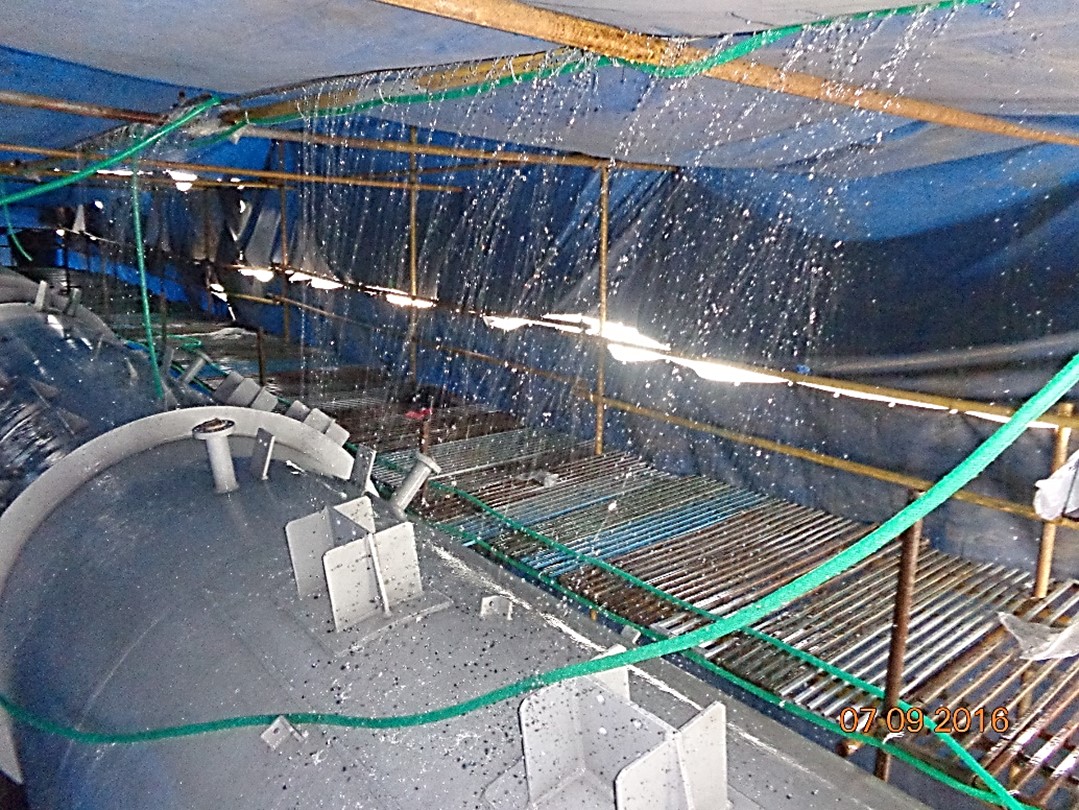Introduction:
Thermal spray aluminum (TSA) coating plays a vital role in protecting critical equipment used in the oil and gas industry from corrosion and other environmental factors. To ensure the reliability and effectiveness of TSA coatings, the water spray test is an essential procedure. This blog explores the significance of the water spray test in the context of TSA for the oil and gas industry and provides a recommended procedure for conducting the test. Although, there is no as such requirement of water spray test in any of the standard, but the test is recommended in various global specification based on the intermittent input and concern raised at site over a period of time in regards of quality and performance.
Basic Step:
- Step 1 : After completion of the TSA, ensure DFT reading is as per the requirements.
- Step 2 : Arrangements for water spray test (Refer photo). Water hose with multiple holes arranged on top of the equipment will sprinkle water on the job. Pump shall be arranged to continuous flow on the job.
- Step 3 : Continuously wetting the surface for 24 hours
- Step 4 : Allow the surface to dry for 24 hours and perform visual inspection for rust bloom
- Step 5 : Ratification as per repair procedure in case of visible rust bloom
Equipment and Setup:
• Ensure a controlled and well-ventilated environment.
• Prepare a water spray apparatus with adjustable pressure and a suitable nozzle.
• Set up a test specimen rack to accommodate the TSA-coated samples.
Sample Preparation:
• Apply the TSA coating on a representative sample according to the specified process parameters.
• Allow the coated component, items or equipment to cure/dry where coating touch up might have required which is as per the coating manufacturer's recommendations to be performed.
Pre-test Inspection:
Conduct a visual inspection of the TSA-coated sample for any visible defects or irregularities.
Verify that the coating thickness is within the specified range.
Water Spray Test:
• Position the coated sample in the test specimen rack.
• Adjust the water pressure to the desired level, typically within the specified range.
• Direct the water spray nozzle at a consistent angle and distance from the sample surface.
• Activate the water spray and maintain the spray for the specified duration.
• Observe and record any changes or defects that occur during the test, such as blistering, delamination, or corrosion.
Post-test Evaluation:
• Inspect the TSA-coated sample after the water spray test for any visible damage or changes.
• Assess the extent of any defects, such as blistering or delamination, and record their severity.
• Measure the coating thickness again to determine if any changes occurred during the test.
Analysis and Reporting:
• Analyze the test results to evaluate the performance of the TSA coating.
• Compare the observed defects or changes to the acceptance criteria or industry standards.
• Prepare a comprehensive report documenting the test procedure, observations, and conclusions.
Significance of the Water Spray Test:
- Corrosion Resistance Evaluation:
- The water spray test simulates the harsh operating conditions experienced by TSA-coated equipment in the oil and gas industry, such as exposure to saltwater or corrosive chemicals. It helps assess the coating's ability to withstand corrosion and ensures long-term protection.
- Adhesion and Cohesion Testing:
- The test evaluates the adhesion strength between the TSA coating and the substrate material. It identifies potential issues like inadequate bonding, which can lead to coating delamination or failure.
- Coating Integrity Assessment:
- The water spray test reveals any defects, such as blistering or pinholes, that may compromise the integrity of the TSA coating. By identifying such weaknesses, appropriate remedial measures can be taken to ensure the coating's effectiveness.
- Quality Assurance:
- Conducting the water spray test as a part of quality assurance practices helps ensure consistent coating performance across different TSA applications. It aids in verifying that the coating meets the required specifications and industry standards.
Reference Website:
For more in-depth information on the water spray test in thermal spray aluminum coatings, you can refer to the following website:
Title: "Water Spray Test for Coatings"
Website: www.example.com/water-spray-test-for-coatings
Conclusion:
The water spray test is a crucial step in evaluating the performance and durability of thermal spray aluminum coatings used in the oil and gas industry. By subjecting the TSA-coated samples to simulated environmental conditions, the test helps identify potential issues and ensures the coatings meet the necessary corrosion resistance standards. Implementing the water spray test as a quality assurance measure can enhance the reliability and longevity of TSA coatings, protecting critical equipment and infrastructure in the oil and gas sector.
Furthermore details, contact us,
BG Group of Paint and Coating Consultant
E-mail: support@bgcoating.com
Contact/WhatsApp No: +919925810408
Website: https://bgcoating.com/






